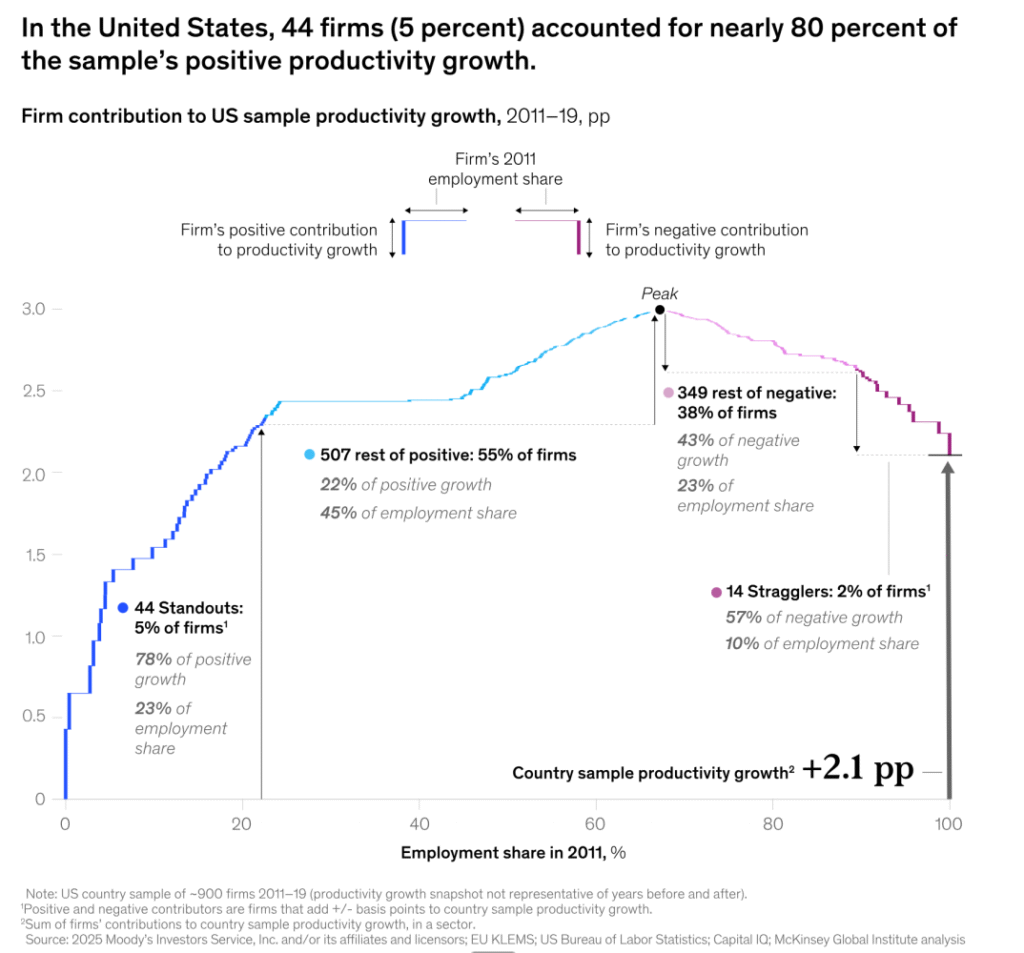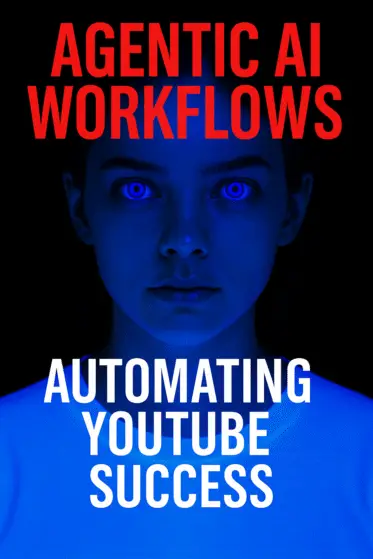Welcome to AI Leader Edge, where we provide thoughtful leadership on AI and factual assessments of AI tools to help you make informed decisions. Interested in exploring 3,500+ additional AI tools? Visit the AI Leader Edge Toolbox to discover, learn about, and implement unique AI solutions that can enhance your creative and business processes.
Today, let’s analyze McKinsey’s new Power of One study, revealing that national productivity is driven by very few standout firms. In the United States, for example, just 44 companies, about 5% of large firms, produced nearly 80% of all productivity growth over 2011–19. Productivity advances came not from every company grinding out incremental gains, but from powerful leaps by a handful of leaders. As the report notes, “productivity grows in powerful bursts as firms find new ways to create and scale new value”, whether Apple expanding into services, easyJet innovating airline travel, or Zalando scaling online apparel sales.
This insight, that few firms move the needle a mile rather than many moving an inch, underscores how a small number of firms can reshape an economy.
- Skewed Contributions: Fewer than 100 “Standout” firms (out of ~8,300 studied) accounted for two‑thirds of productivity. In the U.S., these 5% of firms, holding just 23% of jobs, generated ~78% of the country’s productivity. By contrast, a small number of Stragglers (inefficient firms) dragged down growth. This superstar dynamic suggests that economies thrive when their top innovators thrive.
- New Value vs. Efficiency: Unlike traditional efficiency drives, growth came from business model innovation and new value creation. Standouts scaled radically different models: Apple in mobile services, Amazon in e‑commerce, Zalando in online retail, and easyJet in discount air travel. They shifted resources to high‑value products (e.g., Nissan’s EVs, Apple’s services, Amazon Web Services) and rewrote customer propositions (e.g., Home Depot’s omnichannel shopping, airlines’ loyalty offerings). McKinsey concludes that the focus must be on bold value creation and reallocating talent and capital to the few winners, not just cost‑cutting across all firms.

Source: McKinsey The power of one: How standout firms grow national productivity
AI-Native Versus Adapted: Who Drives Productivity?
A key theme for #AILeaderEdge is the gap between AI-native firms and traditional companies adapting to AI. McKinsey’s standout examples highlight both: technology-born giants like Apple, Amazon, and Nvidia (“frontier” innovator firms) and more incumbent players like Home Depot, United Airlines, or Tesco (historical leaders that had to digitally transform). The difference is instructive. AI-native firms began life with data‑driven, software-enabled business models. They enjoy network and scale effects (e.g., AWS’s cloud, Nvidia’s GPUs for AI) that let them rapidly capture new markets. These companies are more likely to be in the top productivity frontier to begin with, and they can inject further leaps through continuous AI innovation.
By contrast, incumbent firms often started with analog or legacy processes and must retrofit new technology. To become Standouts, they needed dramatic strategic shifts. For example, McKinsey cites:
- Retailers: German discounter REWE launched digital offerings while expanding stores, and British grocer Tesco revamped online channels and loyalty programs to respond to newcomers. In the US, leaders like Home Depot invested in integrated online/in-store experiences.
- Automotive & Aerospace: Carmakers doubled down on high-value portfolios (e.g. more EVs, phasing out unprofitable models).
- High-Tech: Firms like Zeiss and Danaher invested in breakthrough R&D, supplying cutting-edge technology to growing industries.
These incumbent moves often involved adopting digital and AI tools. However, the starting point matters: AI‑native companies already have the data infrastructure and culture to exploit AI breakthroughs, whereas traditional firms must also change mindsets and talent. In short, McKinsey’s narrative implies that AI leaders – those already proficient at deploying AI at scale, will likely replicate the “power of one” phenomenon. Supporting this, separate research shows that “AI leaders” (companies with advanced AI capabilities) enjoyed ~1.5× higher revenue growth and ~1.6× shareholder returns than others. In practice, only about 26% of firms are on track to generate tangible value from AI, meaning most risk falling behind.
Key Insight: The McKinsey report suggests that how a firm adopts technology is as important as what it does. AI‑native firms inherently build scalability into their models, whereas adapted firms must make bold portfolio and business-model changes to catch up. The gap between these two groups will be a major driver of productivity differentials going forward.
Strategic Implications for Leaders and Policymakers
The Power of One findings have several implications:
- Focus on Frontiers: For business leaders, the message is to play to win on core strengths. Investing in AI, data platforms, and new growth engines can propel companies onto the productivity frontier. As McKinsey notes, firms should emphasize value creation – new products, channels, services – rather than only trimming costs. Executives should benchmark against the fast-moving standouts (many of them AI-centric) and ask: Are we scaling our digital business models aggressively enough?
- Talent and Culture: Standouts were not just big, they made cultural bets on innovation. McKinsey asks: “What talent strategies and educational policies can nurture technology and innovation capabilities… for firms to make bold strategic moves?”. In practice, this means training workforces in AI and data science and creating internal incentives to experiment. AI Leader Edge recommends that companies build cross-functional AI teams and reward tangible outcomes, echoing how top AI performers concentrate on mission-critical applications.
- Policy Playbook: For policymakers, the study suggests new levers. Instead of blanket productivity programs, governments might accelerate clusters of innovation. This could include funding AI and digital infrastructure, or partnering with high-potential startups (future Standouts) through incubators and grants. Importantly, labor mobility matters: allowing talent to flow from declining firms to growing ones amplifies the “reallocation” effect McKinsey highlights. Policies that upskill workers in AI-relevant fields and that reduce barriers for high‑growth firms (in financing, trade, or regulation), can help a few winners raise the whole economy. As McKinsey puts it, productivity strategies should “focus on the power of the few” and move resources toward leading businesses.
- Innovation Ecosystem: The report also underscores the role of future standouts. SMEs and startups may contribute modestly now, but they fill the funnel. Continuing to bolster entrepreneurship and R&D creates tomorrow’s Apples and Amazons. In essence, both business and policy must nurture the pipeline: scaling innovation more than just creating new entrants.
In summary, the Power of One study reframes productivity: it’s not a crowd effect but a leadership effect. For the AI Leader Edge community, that means double-down on the AI frontier. Our collective role is to guide organizations toward those high-impact strategies, adopt AI at scale, scale new digital models, and reimagine value propositions. Doing so, we help create the next generation of “red butterflies” that can lift national prosperity.
As an entrepreneur and an educator, I keep asking myself, if I built a business today, how could I make it the most efficient by maximizing the latest technology? It’s a muscle of persistence, change, and innovation. So I’ll leave you with this:
How do you challenge the way you lead today with AI to keep up and reimagine what’s possible?
Explore Additional AI Tools for Creators
Interested in exploring 3,500+ additional AI tools? Visit the AI Leader Edge Toolbox to discover, learn about, and implement unique AI solutions that can enhance your creative and business processes.
Need Expert AI Implementation Guidance?
If you require assistance evaluating these tools based on your specific business model or industry requirements, contact our team at info@aileaderedge.ai. We specialize in helping organizations make informed AI decisions based on potential impact rather than market hype.
Happy strategizing,
Stay Visionary, Lead with an Edge!
P.S. This article aims to inform AI Leader Edge readers about available options for AI adoption and implementation. Knowledge is power. We present AI not as a threat but as an evolution in the dynamic world of digital influence.








